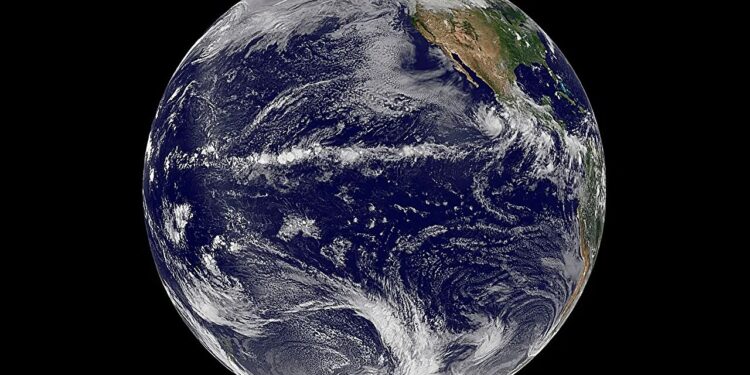Researchers have discovered new underwater faults on the Pacific Plate, some of which lie thousands of meters below the ocean surface and hundreds of kilometers in length. Credit: NOAA/NASA GOES Project
A team of University of Toronto geoscientists is shedding new light on the century-old model of plate tectonics, which suggests that plates covering the ocean floor are rigid as they move through the Earth’s mantle.
Researchers have discovered that the Pacific plate is marked by large underwater faults that tear it apart. The newly discovered flaws, described in an article published in the journal Geophysical research lettersare the result of enormous forces within the plate pulling it westward.
Some faults are thousands of meters deep and hundreds of kilometers long.
“We knew that geological deformations such as faults occurred inside continental plates, far from plate boundaries,” says Erkan Gün, a postdoctoral researcher in the Department of Earth Sciences in the Faculty of Arts and Sciences. “But we didn’t know the same thing happened to ocean plates.”
Russell Pysklywec, professor in the Department of Earth Sciences, adds that the research contributes to a better understanding of the field.
“What we are doing is refining plate tectonics – the theory that describes how our planet works – and showing that these plates are not as pristine as we previously thought,” says Pysklywec.
Other researchers involved in the study include Phil Heron, assistant professor in the department of physical and environmental sciences at the University of Toronto Scarborough, as well as researchers from the Eurasia Institute of Earth Sciences at the Technical University from Istanbul.
For millions of years, the Pacific Plate, which makes up most of the Pacific Ocean floor, has drifted westward to dip into the Earth’s mantle along submarine trenches or subduction zones that extend from Japan to New Zealand and Australia. When the west edge of the plate is lowered into the mantle, it pulls the rest of the plate with it like a tablecloth pulled from a table.
The newly discovered plate damage at faults occurs in vast suboceanic plateaus formed millions of years ago when molten rock from Earth’s mantle was extruded onto the ocean floor; faults tend to run parallel to the nearest trench.
“It was thought that because the suboceanic shelves were thicker, they should be stronger,” says Gün. “But our seismic models and data show that it’s actually the opposite: the plateaus are weaker.”
In other words, while the Pacific plate looks like a tablecloth pulled across a table, the platters are pieces of fabric that are more fragile and more likely to tear.
The researchers studied four shelves in the western Pacific Ocean: Ontong Java, Shatsky, Hess and Manihiki, in a large area roughly bounded by Hawaii, Japan, New Zealand and Australia. They made their discovery using supercomputer models and existing data, some collected during studies carried out in the 1970s and 1980s.
“There is evidence that volcanism has occurred at these sites in the past as a result of this type of plate damage, perhaps episodically or continuously, but it is unclear whether this is currently occurring “, explains Gün. “Yet we can’t be sure because the plateaus lie thousands of meters below the ocean surface and sending research ships to collect data is a major effort. In fact, we hope our paper will draw attention to the sets and more data will be collected.
The theory of plate tectonics has been refined over the decades by many Earth scientists, including John Tuzo Wilson of the University of Toronto, who made important contributions during his career.
“But the theory is not set in stone and we are still finding new things,” says Pysklywec. “We now know that this damage caused by this fault tears the center of an oceanic plate, which could be linked to seismic activity and volcanism.
“A new discovery like this shakes up what we have understood and taught about the active Earth,” he says. “And it shows that there are still radical mysteries even about the grand workings of our evolving planet.”
More information:
Erkan Gün et al, Syn‐Drift Plate Tectonics, Geophysical research letters (2024). DOI: 10.1029/2023GL105452
Provided by University of Toronto
Quote: Geoscientists discover that the Pacific plate is marked by large underwater faults which tear it apart (February 6, 2024) retrieved February 6, 2024 from
This document is subject to copyright. Apart from fair use for private study or research purposes, no part may be reproduced without written permission. The content is provided for information only.



